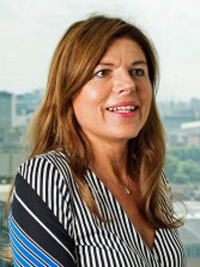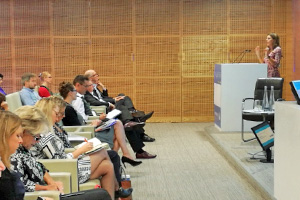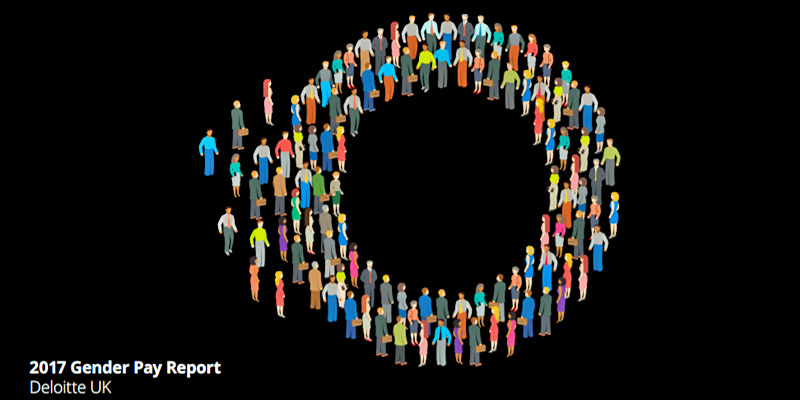Emma Codd is Managing Partner for Talent at Deloitte North West Europe and the UK firm, a member of the firm’s Executive, as well as being a partner in the Forensic practice, where she established and manages Business Intelligence Services. Previous roles include the UK member of the Global Young Partner Advisory Council and Chair of the UK Executive Advisory Group. Emma was involved in the diversity, respect and inclusion agenda and was the sponsoring partner of the UK firm’s Women’s Network until her appointment to the Executive.

“…I’d reinforce the importance of great internal communication. We have a view that our people shouldn’t be reading in the media anything on gender pay that we haven’t already shared with them…”
My career to date
I started out at work back in the late 80s, albeit this wasn’t in professional services. In fact I would go so far as to say I didn’t have a wish to work in professional services, so when I was at university I studiously avoided the milk round. By graduation time I had decided that what I really wanted to do was to work in the corporate investigation sector. During my last year at university, I’d managed to get some work for an American corporate investigation company so I left university with a history degree and, very randomly, ended up as a corporate investigator.
I started off as a researcher and then progressed to set up own business with another individual which we sold after three years; I ended up at Deloitte in 1997. I joined with a plan only to stay for three years, and the rest is history.
I joined Deloitte to set up an integrity risk practice and loved it from the start – within weeks of joining I had realised how amazing it was to work for a large organisation with all the support and opportunities you got – so I stayed. I made partner in 2003.
While I still do my original role, I was also appointed as Managing Partner for Talent in 2013 – this means I’m effectively responsible for everything that we do in our organisation from a talent perspective. Although I now spend much of my time on talent – particularly as we have been going through so much change over the past four years – I still have a number of clients that I lead work for.
Last June we became Deloitte North West Europe and I was appointed to the role of Managing Partner for Talent for NWE; so I conduct my UK role (which encompasses around 17,000 people) alongside that for NWE (around 34,000 people, including the UK). I have talent partners in the other North West European geographies that I work very closely with, but there is still much to do in both roles.
I have to balance this alongside my family – I am married and have two incredible eight year old daughters who also need quality time with me. I think it is this personal need to balance work and life that has made me more determined to ensure that we always provide a workplace where people are able to achieve a balance between work and life – a major focus for the firm since I took on the talent role.
My working life is very busy and I have had to learn to really make sure that I’m focusing on the right things across both aspects of my job. It makes you stand back and basically say: “Do I really need to be involved in this particular element?”. It actually makes you focus on the areas where you can most add value.
Role on a day to day basis
My role varies and no two days are the same! I can get a call at any time from a client saying: “I need some help on this particular project,” and then the reality is that the next few hours are spent putting the project team together, defining the scope of work, making sure that we’re able to do the project – really advising the client in terms of what direction they want to go.
From a talent perspective my day can be extremely varied – it can mean sitting down with my team going through the latest stats related to key talent issues: for example, our focus on gender diversity, which is a critical priority for the firm. We regularly have a look at how impactful our focus has been. This includes going through data and discussing the impact of specific actions – including looking at whether we need to flex our approach.
There’s quite a lot of time spent in meetings – something I’d like there to be less off! I constantly challenge myself and those I work with as to whether we really need to have a meeting on an issue or is it something we can deal with through a simple phone discussion. The other thing for me is blocking time out in my diary where I can really challenge myself.
We have a very clear strategy that has a clear focus and we’re midway through delivering against this. Every so often it is important to sit back and reflect on what we are doing. Is it still the right thing? Or do we need to change our focus slightly? That applies for every talent priority we’ve got, so it is really important that I have some time to reflect.
In my role as Managing Partner of Talent I have a policy where my door is always open, metaphorically speaking – if any of our people have issues or concerns, it’s important that they feel able to come and see me. Even though I’m in a senior position in the organisation, I’m very, very clear that I want to hear from our people and I want to know how they feel. I want to understand if they’ve got challenges and equally to understand where things are really working well – is it something we can learn from.
So, on a weekly basis I will have people I’ve never met before coming and sitting down with me and giving me their views in an open way. I often find these meetings to be invaluable.
No two days are the same. They are very wide-ranging and I love it. I couldn’t have dreamed of a better job.
I also spend a lot of time now talking to our clients about the work we are doing on gender, agile working, respect and inclusion. As we’ve started to see some real change around gender in particular we’ve found that many of our clients want to have a conversation with us to find out what we’re doing that’s made a difference. These conversations are a chance for us to share what we have done and to learn from what others are doing.
Finally, it is worth noting that – while I am office-based for much of the time – I also try and spend a day a week working from home. I’m very good at sitting down and just focusing and I find the time incredibly useful. My chosen day is a Friday and I’m very open at work about this being because it means I can do the school pick up. I’m very clear with people that – unless it’s really urgent – I will not be contactable between the hours of around 3.00pm and 4.30pm on a Friday because I’m walking my children home from school. I then pick up online after that again. So I work in a way that is very agile and works for me.
Voluntarily reporting our gender pay gap since 2015
I am a huge believer in gender pay transparency, as is our CEO, and the rest of our leadership. We voluntarily reported for the first time in 2015 and reported again in the summer of 2016. While we were reporting that we had a gap, and doing so before most other companies, it was seen by our people as very positive. This is a sentiment that has continued.
When the Government first started talking and consulting on the gender pay gap legislation I was very supportive and clear that this was the right thing to do. In my view, transparency drives action and the fact that every large organisation will have a snapshot from the same date so you can compare like for like is a real positive.
Future employees, for example, are able to sit and look at what’s on the Government Equalities Office portal and – if they want to – go to the narrative on a company’s website to take their own decision as to whether this is an organisation that is serious about gender balance.
One important thing that we learned from our reporting was how important it was to have already had a plan in place to deal with gender balance. When we first reported in 2015 we did so having already published our gender balance action plan to our people.
In 2012 we had agreed targets for the number of female partners that we wanted to see by 2020; namely that by 2020 25% of our partners will be female. When we set our target this figure stood at 12%. In 2013 when I started my talent role we had not seen much progress towards that target – so my CEO and I sat down, agreed this was really a high priority and determined that we needed a firm plan of action in place. We developed this plan through analysis of data and listening to our women – we asked them what would make their experience with us the best it could be.
The resultant plan focused on culture and targeted actions aimed at removing what I call ‘pain points’ in our career life cycle. We made this plan available to our people and explained why change was so important – why we needed to take action. By the time we published in 2015, our people knew that we had a clear path to close it.
From next April all large employers will have to report their #genderpaygap. We are leading the way by publishing our data early. pic.twitter.com/saJ8BnTYAl
— Emma Codd (@emmajcodd) December 9, 2016
Our gender pay gap is about the way our organisation looks, the way it’s made up from a senior perspective – we do not have enough women in the most senior positions in our firm. But we are committed to changing that and are making progress.
Lessons learned for the organisation
If I was giving tips, I would say to use the data that calculating your gap gives you. It will tell you thing you don’t know. Even in 2017 when we’d reported twice before, it showed us things that we didn’t know. For example, our analysis showed us that all our focus on agile (otherwise known as flexible) working is paying off – over three years we had gone from a very low proportion of our women working in an agile way to an excellent proportion.
We fully support #genderpaygap reporting and see today as a big step forward in the journey to achieve gender parity in the UK pic.twitter.com/T4fLtsJFW1
— Emma Codd (@emmajcodd) April 6, 2017
25% of our women at senior manager level and above are now working on a reduced hours basis and were succeeding in their careers. While we had been seeing a positive move in this direction, it was only when we were actually pulling our data together that we realised: “Wow! This is the progress that we’ve made since we started focusing on this.” So, there are always things that you can learn from the data – I would always say to use it and make sure that you get the benefit of it.
My other advice is timing wise we chose to publish ours early in 2017 because we chose to align it with the other things that we report as a company. This is an important business issue for us and thus we chose to publish our pay gap round about the same time as our Impact Report.
The other thing for us to get exactly right was the narrative – we needed to be able to tell our story and show the steps we were taking to close our gap. We used our own team that advises clients to prepare the narrative for us and they did a great job. What I produced was very wordy and they turned it into something that, in my view, is very user friendly and far better than my version! They came up with some great ideas, such as video case studies. They gave us an excellent opportunity to tell the story behind the numbers.
Finally, I’d reinforce the importance of effective internal communication. We have a view that our people shouldn’t be reading in the media anything on gender pay that we haven’t already shared with them. They should know and understand the causes for it. They can also see how we’re doing on delivering against the plan as we publish and update progress on the Intranet.
Pioneering BAME data reporting
We reported on BAME data as well for the first time this year. We were very lucky that we were able to gather enough data to be able to report – while we still don’t have ethnicity data for all our people, we do have it for the vast majority; this is the result of a campaign through which we explained to our people how their voluntary completion really helps us to measure where we are and to determine targets as necessary.
We will report our ethnicity pay gap data each year as it is an issue that is really important to us. As with gender, we’ve published our BAME action plan, and again that’s out there for our people to see. I have a BAME Advisory Council who regularly come up with different ideas and challenge the organisation to make sure we are continuing to push forward on ethnicity.
Advice for organisations that have yet to report
We took a decision to be an early reporter and have been vocal about our support of gender pay gap reporting. Our people have seen this as a real positive – that we support transparency. I also think a positive for us was our people knowing – prior to our reporting – that we had a credible action plan in place to close our gap, that this plan was led from the top of our firm, and that we were already showing progress in the right direction.

One would be hopeful that all the organisations that have yet to report are just spending lots of time getting the narrative right. I think there is obviously going to be a flurry before the deadline, but equally I think there will be quite a lot of attention paid to those that do report late.
We took a view that we were going to put ourselves out there, we were going to go very early because it was very important to us. Obviously people will make different choices based on what’s right for their organisation – it was right for us to report early.
Coming up next
From a Deloitte perspective we’ll continue down our road on gender balance. This is a long journey and it’s not something you can change overnight. We need to continue to deliver what we said we’ll deliver.
From an ethnicity perspective it’s again about driving those actions that we’ve said we’ll take to close the gap.
For us there’s also a big focus on respect and inclusion and great people leadership – on making sure that we are providing an environment where everybody can succeed.
For me personally, it’s more of the same, even though no two days are the same – the talent environment is changing so quickly that you have to be very fast in response. It’s a good job I enjoy being busy!
https://www2.deloitte.com/uk/en.html
https://twitter.com/deloitteuk





